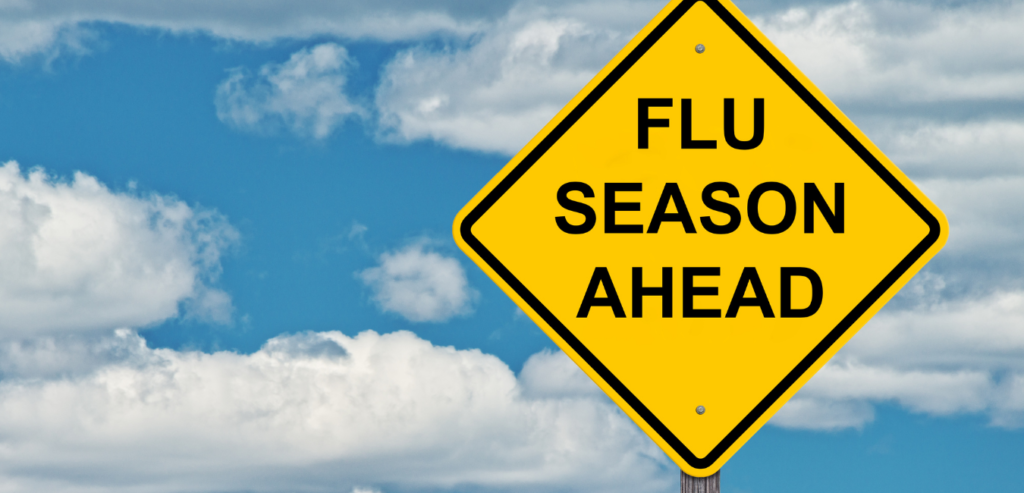The flu may have been upstaged by its big-brother COVID-19, but that doesn’t mean that it's gone away for good. Flu season is here once again, and the need to protect yourself and your loved ones is just as great as ever.
Q: When is Flu Season?
A: Flu season in the U.S. runs from October to as late as May.
Flu season is the time of peak influenza spread, and how severe a given season is depends on a variety of factors. In the United States, flu season always starts in October, but it can peak any month from December to March. Flu season ends in either April or May.
In the southern hemisphere, the flu season aligns with the cold weather as well and so lasts from April to September. Meanwhile, areas without a distinct winter may see flu season during times which seem odd to those in more temperate zones. For instance, in New Delhi flu cases peak July through September.
Q: Why is the flu seasonal?
A: We don’t know for sure. Scientists believe that it is a combination of two things: people crowding together indoors during colder weather, and lower moisture in the air allowing the virus to travel further and remain in the air longer. This also applies to some other respiratory illnesses, which is why the season is sometimes called “cold and flu season.”
Lower vitamin D levels from shorter days and spending more time indoors might also be partially to blame.
Q: What causes the flu?
A: The flu is caused by certain types of the influenza virus. Two types in particular (the dully-named Influenza A and Influenza B) are typically responsible for flu season. These influenza viruses are not a single identical species, but categories which include many different subtypes, lineages, clades, and subclades of influenza. When a flu pandemic occurs, as one does every few decades, Influenza A is the culprit. Influenza B still makes plenty of people sick, however, even if it gets less press.
Q: How is the flu spread? Q: How long is the flu contagious for?
A: The influenza virus enters the air via droplets exhaled, coughed, or sneezed by an infected person. The virus can then be inhaled by an uninfected person, resulting in a new influenza case. Alternatively, these droplets can fall onto surfaces, infecting people when they later touch their nose, eyes, or mouth.
Healthy adults can spread the flu to others from about one day before their symptoms begin up to seven days after becoming ill. Children and adults with weakened immune systems may be contagious for longer.

Q: What are the symptoms of the flu?
A: Symptoms of the flu include headache, fever, cough, runny nose, sore throat, chills, fatigue, and body aches. The flu can also cause vomiting and diarrhea, especially in children. Some people, however, never become symptomatic at all.
Q: Is the flu dangerous?
A: Yes. Though it may not make headlines as often as big bads like Ebola, the flu is plenty deadly. Influenza kills somewhere between 290,000 and 650,000 people per year globally. On top of that, the flu has caused four pandemics in the past 100 years. More people were killed in the 1918 flu pandemic than during all the combat of World War I.
Q: How is the flu different from COVID-19?
A: Soup to symptoms, this may all sound similar to COVID-19, but it's important to distinguish how the two infectious diseases are different.
First and foremost, they are caused by different viruses. COVID-19 is caused by the Severe Acute Respiratory Syndrome Coronavirus 2 (or SARS-Cov-2 for short), while the flu is caused by the influenza virus.
Secondly, the incubation and recovery periods for the flu are generally shorter than those for COVID-19; the flu only incubates for one to four days, and most healthy adults recover in a week after the symptoms appear. Meanwhile, COVID-19’s inucbation period varies widely, and it takes most healthy adults at least two weeks to recover.
Thirdly, while COVID-19 symptoms and flu symptoms can present similarly, the flu is less likely to cause a complete loss of taste and smell (other than that which might be expected from a stuffy nose).
Finally, while the flu both hositalizes and kills many people each year, COVID-19 hospitalizes and kills a much greater percentage of those it infects. For instance, over the past decade, the flu killed somewhere between 12,000 and 52,000 people per season in the United States. COVID-19 has killed more than 700,000 Americans in the last two years alone.
Q: Who is at risk for the flu?
A: Everyone is at risk for the flu, but some people are more at risk than others. Like COVID-19, those older than 65 and those with underlying health problems or chronic medical conditions (such as kidney disease, heart disease, or diabetes) have an increased risk of hospitalization and death.
Those who are pregnant and children under five also have a high risk of developing complications. During the 2009 flu pandemic, 80% of children who died from the flu were not fully vaccinated.
This doesn’t mean that healthy young-adults get off scot-free, however. A young person’s immune response can become too robust, causing what is known as a cytokine storm. This occurs when an immune system produces too many cytokines (substances that tell immune cells to report for duty), causing the lungs to inflame. This can lead to secondary bacterial infections and even death in young and healthy individuals. This reaction is more commonly produced by novel (new) pandemic flu variants than it is in the ordinary flu season, but it stands as a reminder that everyone should take precautions against the flu.
Q: How does the flu impact businesses and the economy?
A: A study by the National Center for Immunization and Respiratory Diseases found that the flu is expensive for employees and businesses alike. In 2003, the flu cost U.S. employees more than $10.4 billion in lost wages (or $15.5 billion adjusted for inflation), and cost the economy as a whole $87.1 billion (or $129.85 billion adjusted for inflation). This doesn’t include the more than 600,000 lost life years due to sick time or approximately 3 million hospital visits. This is merely the economic loss from a single year in a single country.
Q: Why did the flu disappear last year?
A: It didn’t. However, last flu season was rather mild. There are a few theories as to why this might be.
First, since SARS-CoV-2 and Influenza spread in similar ways, precautions such as social distancing, hand washing, and masks (see below) may have helped to reduce the spread of the flu as well.
Secondly, both SARS-CoV-2 and influenza attack respiratory cells. Since the viruses were competing for the same resources (i.e. our lungs) and because COVID-19 is more contagious than the flu, it is possible that COVID-19 out-competed the flu last season. This is called viral interference.
Finally, a record number of people received the flu vaccine last year.
However, this is not cause for complacency. Some doctors warn that the 2021-2022 flu season might be more severe than normal. This prediction stems from the fact that many people’s immune systems haven’t needed to fight off the influenza virus for two years now, as well as the assumption that people are growing less cautious due to lockdown fatigue. At the time of writing, however, this is merely a hypothesis.
Q: Do masks help prevent the spread of the flu?
A: In a healthcare setting, masks are recommended “for patients being evaluated for respiratory symptoms” and healthcare workers, per the Center for Disease Control. While masks can indeed reduce the rate of respiratory infection, they are not currently recommended in a non-healthcare setting as an influenza precaution. (They are, however, still recommended as a COVID-19 precaution.)
This isn’t because masks don’t work; masks are actually an excellent flu precaution to take at home when someone is sick. However, because people are unlikely to use them as often as necessary, other precautions are more strongly recommended.
Q: What is the best way to protect myself and others from the flu?
A: According to the CDC, “The single best way to reduce the risk of seasonal flu and its potentially serious complications is to get vaccinated each year.” Don’t want to take the CDC’s word for it? Let’s see what the Mayo Clinic has to say: “Getting an influenza vaccine — though not 100% effective — is the best way to prevent the misery of the flu and its complications.” Still not convinced? The U.S. Army, Navy, and Airforce each aim to have 90% of their active and reserve personnel vaccinated this season.
Q: Why is it so difficult to make a cure for the flu? Why do I need to get the vaccine each year?
A: The influenza virus undergoes a process called antigenic drift. Each time the virus replicates, tiny errors occur in the antigens (proteins on the outside of the virus that are recognized by the immune system). Eventually these errors accumulate to the point that the immune system no longer recognizes the flu as a virus it has fought before. This process makes it very difficult to come up with a single vaccine for all possible flu varieties across all possible flu seasons.
When developing a flu vaccine, scientists take thousands of sequenced genetic samples and try to predict what variants will be the most prevalent in the upcoming flu season. They then create a single vaccine to protect from these new strains. Most flu vaccines contain protection against two types of influenza A and two types of influenza B.
Q: How does a flu vaccine work?
A: Most flu vaccines contain inactivated viruses. An inactivated flu virus is merely the outer protein shell of the virus; thus, the virus is effectively dead. Des Moines University says this shell can be thought of as what the virus is “wearing.” The vaccine trains your body's immune system to attack viruses “wearing” certain proteins.
There is also a nasal spray form of the flu vaccine containing a live attenuated (i.e. weakened) form of the virus, but this is in limited use.
If scientists correctly predict which four flu strains will be the biggest threat, the flu vaccine is 40% to 60% effective at preventing flu infections. At first blush, this may not seem to be a high success rate. However, this success rate prevented 7.5 million flu cases in the 2019-2020 season alone.
More importantly, those who get the flu vaccine have a reduced risk of being hospitalized or dying if they do get the flu. Getting the flu vaccine may also protect others, especially young children and the elderly.
Q: Are flu shots safe? Are flu shots FDA approved? Do they have any side effects?
A: Yes, flu vaccines are safe and approved by the FDA.
Since the virus is inactivated (in the injectable form), you cannot get the flu from a flu shot. Some people experience mild symptoms for a time (such as muscle aches), but these symptoms are just a sign that their bodies are responding to the flu vaccine with a robust immune response; (this can be thought of as the body training to fight the flu). These symptoms are much less severe than the flu itself.
In extremely rare cases, some people do indeed have severe allergic reactions to the flu vaccine. If these reactions occur, they are likely to occur in the first few minutes to the first few hours of receiving the vaccine. According to the CDC, those who have had a severe reaction to the flu vaccine in the past should not receive it again.
However, the chance of having a life-threatening allergic reaction from a flu vaccine is quite nearly one in a million. Meanwhile, an individual’s chance of getting the flu each year is somewhere between one in twenty (for a mild flu season) and one in five (for a severe flu season). Clearly, flu vaccines are the safer bet for the vast majority of individuals.
Q: Should I get the flu shot if I have egg allergies?
A: There are three ways to make a flu vaccine. The most common method involves growing flu viruses in chicken eggs. This means that most flu vaccines contain a very small amount of egg protein.
People with egg allergies should speak to their doctor before receiving the flu vaccine, as the various considerations can become complex.
Neither the CDC nor the American Academy of Allergy, Asthma, and Immunology recommend observation of individuals who have a mild reaction to eggs (such as hives). If a person has a more severe allergy than this, that person should have their vaccine administered by a healthcare professional capable of recognizing the signs of an allergic reaction.
Q: Are flu shots free and available now in my area?
A: Flu shots are free with most insurance. For those without insurance, many county health departments offer free shots as well. For those who absolutely must pay out of pocket for whatever reason, the flu shot costs between $20 and $85 dollars.
As for availability, there’s no excuse. Flu shots are available anywhere from big box stores to universities to pharmacies to urgent care centers.
Q: Do Air Purifiers help prevent the flu? What is the best purifier for flu season?
A: During the 1918 flu pandemic, the prevailing theory was that fresh air would help reduce the spread of the disease. There was a great deal of wisdom to this, even if the science behind it was not fully understood at the time.
Today we know that outdoor air contains natural scrubbing molecules formed by sunlight and water vapor that break down bacteria, viruses, mold, and fungi. Some active purifiers (such as those made by ActivePure) reproduce this natural effect. Though not a replacement for other flu season precautions, ActivePure has proven effective at reducing enveloped viruses in the air and on surfaces, including various forms of influenza virus.
Passive air purifiers, such as those with a HEPA filter, can be helpful for reducing certain particles in the air, but they are less effective at reducing the smallest viruses.
Q: What about using essential oils for flu season?
A: Essential oils are wonderful things, but they are a tip for easing the symptoms of flu, not preventing or curing the flu.
A study received some excited press when it was discovered that a diluted essential oil blend killed flu cells in a petri dish without killing the kidney cells that were also in said petri dish. However, this doesn't mean you should run to drink clove oil if you are sick. In fact, consuming essential oils is quite unsafe. Even using essential oils externally can irritate the skin, eyes, and lungs if they are undiluted.
If you have the flu (or are caring for someone with the flu) essential oils must be diluted with a carrier oil (about one ounce of carrier oil per few drops of essential oil). Then they may be used as a rub, bath additive, or compress to relieve cough or sinus congestion. Lemon, peppermint, and chamomile are examples of oils favored for this purpose.
Q: What are some other good ways to stay healthy (and keep others healthy) during cold and flu season?
A: First, your mother was right; you should have listened to her all along. Wash your hands after coughing, sneezing, or blowing your nose. Wash your hands also before eating or touching your face.
Second, your mother was right again when she told you to cover your mouth...sort of. Cover your mouth with a tissue rather than your hand. If a tissue isn’t available, use the crook of your elbow. Sneezing or coughing into your hands can spread the virus to whatever surface you touch next.
Third, stay home if you are sick. Workplaces, schools, and public transit are excellent places to spread the flu to the next person. If there was one benefit to the COVID-19 pandemic, it was the normalization of employees calling out when sick. So if you are sick, do the responsible thing and don’t show up to work today.
Fourth, don’t touch your face. The flu can jump from infected surfaces to your hands, and from your hands to your nose, mouth, or eyes.
Fifth, avoid close contact with people who are sick. When you are sick yourself, avoid being in close contact with others.
Finally, get enough sleep. It's pretty clear that insufficient sleep impairs the immune system. After all, how many times have you gotten sick after pulling an all-nighter to finish that project? Don’t. It's not worth your health, and you’ll finish it faster in the morning anyway.
Some Final Words:
The flu, while not as deadly as COVID-19, is still a dangerous and costly infectious disease. Taking some simple measures of disease control and prevention can help us all stay healthy this flu season. After all, they say an ounce of prevention is worth a pound of cure. As there is no cure for the flu (only treatments), we’ll take all the prevention we can get.



